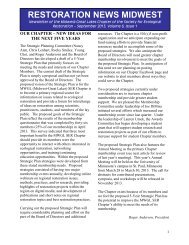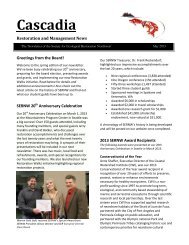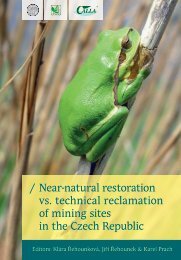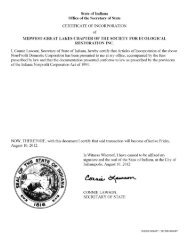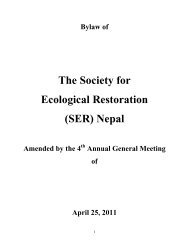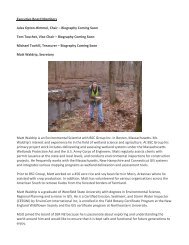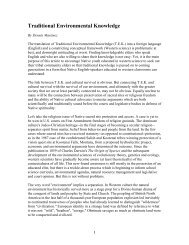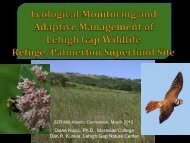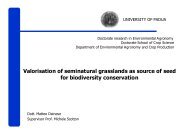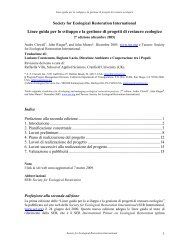THE WORLD CONFERENCE ON ECOLOGICAL RESTORATION
A Global Challenge - Society for Ecological Restoration
A Global Challenge - Society for Ecological Restoration
You also want an ePaper? Increase the reach of your titles
YUMPU automatically turns print PDFs into web optimized ePapers that Google loves.
2005 The World Conference on Ecological Restoration 31<br />
include U.S. Forest Service, U.S. Fish and Wildlife Service, U.S. Geologic Survey, Rocky Mountain National<br />
Park, local Open Space Departments, and recreation clubs. Restoration design professionals, graphic designer,<br />
backhoe operator, and tree thinning service offer discounted services. WRV seeks participation<br />
from diverse groups; four wheel drive clubs helped restore habitats extremely eroded by off road vehicle<br />
use. Not just for people who can move boulders, stake erosion control matting, and rake seeds – volunteers<br />
participate in fund raising, project design, web site maintenance (http://www.wlrv.org/), cooking for<br />
crews, and providing campfire music. Project duration ranges from an evening of seed gathering to a day<br />
on site to a camping weekend. WRV’s program of volunteer restoration projects works because the projects<br />
are fun and highly social, use a variety of skills, are located in beautiful settings, and build empowerment<br />
to care for the land. By the end of the 5 th season, volunteers had completed 65 projects and donated<br />
37,000 hours to improve ecosystems as WRV seeks to put restoration “In Our Own Hands.”<br />
Keywords: restoration, volunteers, public lands, empowerment.<br />
Ecological restoration of coral limestone quarries on the Kenian coast<br />
Baer S.<br />
Lafarge Eco Systems, P.O.Box 81995, Mombasa, Kenya<br />
The restoration of a cement factory’s coral limestone quarries on the Kenyan coast, started in 1971. Approx.100ha<br />
of former quarries has been restored to date into a mosaic of indigenous coastal forest<br />
ecosystems, lakes, wetlands and grasslands. Another 100ha are in various stages of restoration, with the<br />
area increasing as mining continues. Initially Casuarina equisetifolia is planted as pioneer species to colonize<br />
the open quarry, and over the years create humus from leaf litter and a suitable microclimate for<br />
other plant species to grow. Over the past 15 years more than 400 coastal plant species have been introduced<br />
into the mature Casuarina plantations. While the main aim is to create diversity, special emphasis<br />
is laid on timber trees and conservation of threatened species. To create grassland the original topsoil is<br />
brought back, and grass planted. Herds of domesticated eland and oryx antelopes speed up the grassland<br />
development as they deposit seeds and nutrients with their droppings when they come to drink<br />
from the quarry ponds. Lakes and wetlands are created by excavating into the ground water, and linked<br />
into a system of lakes, ponds and wetlands. A demonstration fish-farm has been established, and it’s<br />
pumping activity drives the water circulation. Hippopotamus and other wildlife have been introduced and<br />
are the main attraction for the visitors to the quarry nature trails - tourism is the main revenue generating<br />
activity in the rehabilitated quarries, besides forestry and aquaculture.<br />
Keywords: Restoration, diversity, former quarries, tourism.<br />
Soil organic matter accumulation in restored New York wetlands<br />
Ballantine, K.A., R.L. Schneider<br />
Department of Natural Resources. Cornell University. Ithaca. USA<br />
Wetland restoration is increasingly used as a strategy both to address historic wetland losses and to mitigate<br />
new wetland impacts. Limited research has examined the success of restored wetlands in the eastern<br />
U.S. for avifaunal habitat, plant biodiversity and cover; however, less is known about soil development<br />
in these systems. Soil processes are particularly important as soil organic matter, texture, and<br />
other properties are directly linked to wetland functions for water quality improvement. This research examined<br />
soil development processes in 30 restored wetlands in western New York. We compared soil properties<br />
and soil development processes of wetlands of three different ages, e.g. ~2, 10, and 30 years since<br />
restoration, but which were comparable in restoration methodology, soil type, landscape position, and<br />
hydrologic regime. Replicated soil cores from each site were analyzed for soil organic matter content, bulk<br />
density, texture, root abundance, and chemical properties. Aboveground plant biomass and litter were<br />
quantified as key soil contributors. Additionally, replicated litter bags were used to document and compare<br />
rates of litter decomposition. Results suggest that older restored wetlands had different rates of decomposition,<br />
amounts of soil organic matter content, and bulk density than did younger wetlands. All restored<br />
wetlands studied were low in organic matter content relative to natural counterparts. We conclude<br />
that thirty years after restoration, these wetlands do not provide the water quality functions of their natural<br />
counterparts.<br />
Keywords: Wetlands, soil organic matter, soil development, water quality.



